Are you hearing the term CAM in football discussions and wondering what it signifies? This article breaks down the meaning of CAM in football, exploring the role, key attributes, and famous examples of this influential position. CAUHOI2025.UK.COM offers clear, reliable explanations of football terminology to enhance your understanding of the game. Learn about attacking midfielders, playmakers, and football positions.
A Central Attacking Midfielder (CAM) in football is a player positioned in the space between the central midfield and the forwards. This player is the creative force of the team, often referred to as the playmaker. CAMs are known for their technical skills, vision, shooting ability, and passing accuracy. Teams seeking an attractive, attacking style of play highly value them.
1. The Role of a Central Attacking Midfielder (CAM)
The CAM’s primary role is to link the midfield and attack, creating goal-scoring opportunities. They achieve this by:
- Creating Chances: Delivering through balls, crosses, and clever passes to unlock defenses.
- Scoring Goals: Possessing the ability to score from midfield through long-range shots or late runs into the box.
- Dictating Play: Controlling the tempo of the attack and making intelligent decisions in the final third.
2. Key Attributes of a Successful CAM
A successful CAM typically possesses a combination of technical, tactical, and mental attributes:
- Technical Skills:
- Passing Accuracy: The ability to deliver precise passes over varying distances.
- Dribbling: Skillfully maneuvering the ball in tight spaces to evade defenders.
- First Touch: Excellent control to receive the ball cleanly under pressure.
- Shooting: Accuracy and power to score goals from different positions.
- Tactical Awareness:
- Vision: Identifying passing lanes and opportunities that other players might miss.
- Decision-Making: Choosing the right pass, shot, or dribble at the right time.
- Positioning: Finding space between the lines to receive the ball and influence the game.
- Mental Strength:
- Creativity: Thinking outside the box and producing unexpected moments of brilliance.
- Composure: Remaining calm and effective under pressure.
- Confidence: Believing in their ability to make a difference.
3. Famous Examples of Central Attacking Midfielders
Throughout football history, numerous players have excelled in the CAM role. Here are a few iconic examples:
3.1. Zinedine Zidane
Zinedine Zidane, renowned for his elegance and control, remains a benchmark for attacking midfielders.
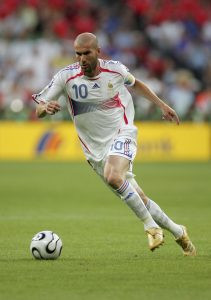 Zinedine Zidane in action for France
Zinedine Zidane in action for France
Zidane’s vision, technique, and ability to perform under pressure made him one of the greatest players of all time. His influence on the game extended beyond individual brilliance; he elevated the performance of his teammates and dictated the flow of matches with his composed presence.
3.2. Paul Scholes
Paul Scholes, a Manchester United legend, was known for his incredible passing range and tactical intelligence.
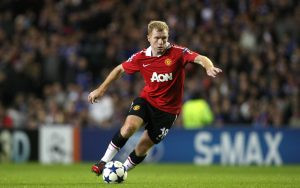 Paul Scholes in a Manchester United kit
Paul Scholes in a Manchester United kit
Scholes possessed the rare ability to control the tempo of a game from midfield, dictating play with pinpoint passes and creating numerous scoring opportunities for his team. His vision and precision made him a key component of Manchester United’s success for many years.
3.3. Andres Iniesta
Andres Iniesta, a key figure in Barcelona’s and Spain’s golden era, was celebrated for his dribbling, vision, and ability to retain possession in tight spaces.
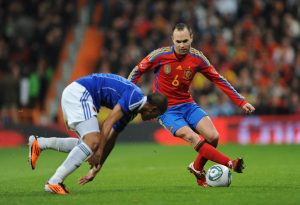 Andres Iniesta in a Barcelona jersey
Andres Iniesta in a Barcelona jersey
Iniesta’s contributions were crucial in securing numerous titles for both club and country, showcasing his importance as a central attacking midfielder.
3.4. Steven Gerrard
Steven Gerrard, a Liverpool icon, was famous for his leadership, powerful shots, and ability to inspire his team.
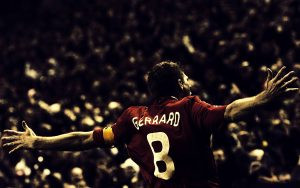 Steven Gerrard in a Liverpool kit
Steven Gerrard in a Liverpool kit
Gerrard’s dynamic play and determination made him a driving force in midfield, capable of changing the course of a game with his individual brilliance.
3.5. David Silva
David Silva, known for his technical skills and creative passing, has been a pivotal player for Manchester City.
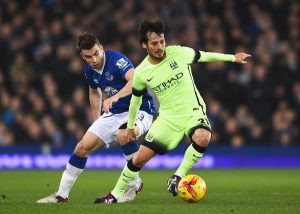 David Silva controlling the ball
David Silva controlling the ball
Silva’s vision and ability to find space in crowded areas have made him a consistent threat in the attacking third.
3.6. Mesut Ozil
Mesut Ozil, with his exceptional vision and passing ability, has been a key playmaker for both club and country.
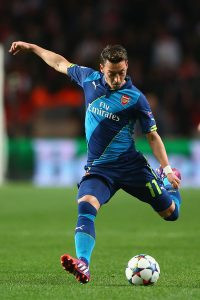 Mesut Ozil in action
Mesut Ozil in action
Ozil’s creativity and finesse in delivering pinpoint passes have made him a valuable asset in creating scoring opportunities.
4. Different Types of CAMs
While all CAMs share the common goal of creating chances and scoring goals, they can vary in their playing style and specific strengths. Some common types include:
- The Playmaker: Primarily focused on creating opportunities for others through passing and vision.
- The Goalscorer: Possessing a knack for scoring goals from midfield through late runs and long-range shots.
- The Dribbler: Using skillful dribbling to beat defenders and create space in the final third.
5. How to Improve as a CAM
Aspiring CAMs can improve their game by focusing on developing the key attributes required for the position. Some helpful tips include:
- Practice Passing: Work on passing accuracy, technique, and vision through drills and small-sided games.
- Develop Dribbling Skills: Improve dribbling skills by practicing close control, agility, and quick changes of direction.
- Improve Shooting Technique: Develop shooting technique by practicing shooting from different angles and distances, focusing on accuracy and power.
- Study the Game: Watch professional CAMs and analyze their movements, decisions, and overall impact on the game.
- Play with Confidence: Believe in your ability to make a difference and don’t be afraid to take risks and try new things.
6. The CAM in Different Formations
The CAM position is most commonly used in attacking formations such as 4-2-3-1, 4-3-3 (with a central attacking midfielder), and 3-4-1-2. The specific role and responsibilities of the CAM can vary depending on the formation and the manager’s tactical approach.
For example, in a 4-2-3-1 formation, the CAM typically plays behind the striker and is responsible for linking the midfield and attack, creating chances, and scoring goals. In a 4-3-3 formation with a central attacking midfielder, the CAM may have more defensive responsibilities, helping to press and win back possession.
7. The Importance of Teamwork and Communication
While individual brilliance is important for a CAM, teamwork and communication are also essential. CAMs must work closely with their teammates, particularly the strikers and wingers, to create effective attacking combinations.
Good communication is also crucial, both on and off the field. CAMs must be able to communicate their ideas and intentions to their teammates, and also listen to and understand their teammates’ needs and preferences.
8. The Evolving Role of the CAM
The role of the CAM has evolved over time, reflecting changes in football tactics and playing styles. In the past, CAMs were often primarily playmakers, focused on creating chances for others. However, in modern football, CAMs are increasingly expected to contribute defensively as well, helping to press and win back possession.
Additionally, the rise of tactical flexibility has led to CAMs being deployed in different positions and roles, depending on the specific needs of the team. Some CAMs may be asked to play as wingers, while others may be used as deep-lying playmakers.
9. The Impact of Analytics on CAM Performance
In recent years, the use of data analytics has become increasingly prevalent in football, including the analysis of CAM performance. Analytics can provide valuable insights into a CAM’s strengths and weaknesses, helping coaches and players to identify areas for improvement.
For example, analytics can be used to track a CAM’s passing accuracy, shot selection, and defensive contributions. This information can then be used to develop targeted training programs and tactical strategies.
10. The Future of the CAM Position
The CAM position is likely to continue to evolve in the years to come, reflecting ongoing changes in football tactics and technology. As the game becomes more data-driven, CAMs will need to be increasingly adaptable and versatile, able to contribute in a variety of roles and positions.
Additionally, the development of new technologies, such as virtual reality and augmented reality, could provide CAMs with new tools for training and tactical preparation. These technologies could allow CAMs to practice their decision-making and vision in a simulated game environment, helping them to improve their performance on the field.
11. The Mental Game for a CAM
Excelling as a CAM isn’t just about physical skills; the mental aspect is equally crucial. Here’s how CAMs can sharpen their mental game:
- Visualization: Regularly visualizing successful plays, passes, and shots boosts confidence and improves execution.
- Focus and Concentration: Developing the ability to block out distractions and maintain focus under pressure is essential.
- Resilience: Bouncing back from mistakes and setbacks is crucial for maintaining performance levels.
- Game Intelligence: Continuously analyzing the game, understanding opponent tactics, and anticipating plays enhances decision-making.
12. Training Drills for Aspiring CAMs
To become a successful CAM, targeted training drills are essential. Here are a few effective drills:
- Passing Accuracy Drills: Focus on short and long passing, using cones as targets to improve precision.
- Dribbling Agility Drills: Set up a course with cones to enhance agility, footwork, and ball control.
- Shooting Power and Placement Drills: Practice shooting from various distances, focusing on both power and accuracy.
- Vision Training: Work with teammates on passing combinations that require quick decision-making and accurate vision.
13. The Physical Demands of Being a CAM
The CAM position requires a unique blend of physical attributes:
- Endurance: The ability to maintain high energy levels throughout the game.
- Agility: Quick changes in direction and speed to evade defenders.
- Strength: Sufficient strength to hold off opponents and maintain possession.
- Speed: Burst speed to exploit gaps in the defense and create scoring opportunities.
14. Tactical Awareness and Game Reading
A CAM’s tactical awareness and game-reading abilities can set them apart. This includes:
- Understanding Formations: Recognizing different formations and knowing how to exploit their weaknesses.
- Anticipating Plays: Predicting where the ball will go and positioning themselves accordingly.
- Making Quick Decisions: Evaluating options and executing the best play in real-time.
- Reading Opponent Movements: Understanding how opponents are likely to react and adapting accordingly.
15. The CAM’s Role in Set Pieces
CAMs also play a crucial role during set pieces:
- Free Kicks: Taking free kicks to deliver accurate crosses or attempt direct shots on goal.
- Corners: Delivering corners with precision to create scoring opportunities.
- Set-Piece Movement: Positioning themselves to receive passes and create chances in the box.
16. Balancing Attack and Defense
While primarily an attacking role, modern CAMs must also contribute defensively:
- Pressing: Applying pressure to opponents in the attacking third to win back possession.
- Tracking Back: Supporting the midfield by tracking back to defend against counter-attacks.
- Interceptions: Making timely interceptions to disrupt opponent plays.
17. How to Analyze CAM Performance
Analyzing CAM performance involves looking at key metrics:
- Pass Completion Rate: Measuring the accuracy of passes.
- Key Passes: Counting passes that lead to scoring opportunities.
- Shots on Target: Assessing the accuracy of shots.
- Assists: Tracking the number of passes that directly lead to goals.
- Chances Created: Total number of opportunities created for teammates.
18. The Psychological Edge of Top CAMs
Top CAMs possess a unique psychological edge:
- Self-Belief: Unshakable belief in their abilities.
- Adaptability: Capacity to adjust to changing game situations.
- Leadership: Inspiring teammates and taking responsibility in crucial moments.
- Mental Toughness: Overcoming pressure and performing consistently.
19. The Influence of Coaches and Mentors
The influence of coaches and mentors is crucial for CAM development:
- Tactical Guidance: Coaches provide the tactical knowledge needed to excel.
- Technical Training: Mentors help refine technical skills and provide personalized feedback.
- Mental Support: Coaches offer mental support and guidance to help players overcome challenges.
20. The CAM and Team Dynamics
The CAM’s relationship with other players is critical:
- Strikers: Providing accurate through-balls and creating scoring opportunities.
- Wingers: Linking up to create effective attacking plays on the flanks.
- Defensive Midfielders: Relying on support to win back possession and start attacks.
21. Common Mistakes to Avoid as a CAM
Aspiring CAMs should avoid these common mistakes:
- Over-Dribbling: Holding onto the ball too long instead of making quick passes.
- Poor Decision-Making: Making wrong choices in crucial moments.
- Lack of Awareness: Not being aware of teammates’ positions and movements.
- Neglecting Defensive Duties: Not contributing enough defensively.
22. The CAM’s Diet and Nutrition
Proper diet and nutrition are essential for maintaining performance:
- Balanced Diet: Consuming a balanced diet with adequate protein, carbohydrates, and fats.
- Hydration: Staying properly hydrated to maintain energy levels.
- Supplements: Using supplements to address any nutritional deficiencies.
23. Recovery and Injury Prevention
Recovery and injury prevention are key to staying healthy:
- Proper Warm-Up: Warming up properly before training and games to prevent injuries.
- Cool-Down: Cooling down after training and games to aid recovery.
- Stretching: Stretching regularly to maintain flexibility.
- Rest: Getting enough rest to allow the body to recover.
24. The Business Side of Being a CAM
The business side of being a CAM involves:
- Agent Representation: Having a good agent to negotiate contracts and manage their career.
- Sponsorship Deals: Securing sponsorship deals to supplement their income.
- Brand Building: Building their brand to increase their marketability.
25. The Longevity of a CAM’s Career
Factors that contribute to a long career:
- Maintaining Fitness: Staying in good physical condition to maintain performance levels.
- Adapting to Change: Adapting to changing tactical demands and playing styles.
- Staying Mentally Sharp: Keeping their mind sharp and focused on the game.
- Avoiding Serious Injuries: Taking steps to prevent serious injuries that could shorten their career.
FAQ: Understanding the CAM Position in Football
Here are some frequently asked questions about the CAM position in football:
Q1: What does CAM stand for in football?
A1: CAM stands for Central Attacking Midfielder.
Q2: What is the primary role of a CAM?
A2: The primary role is to link the midfield and attack, creating goal-scoring opportunities.
Q3: What are the key attributes of a successful CAM?
A3: Key attributes include passing accuracy, vision, dribbling, and decision-making.
Q4: Can you name some famous CAMs in football history?
A4: Famous CAMs include Zinedine Zidane, Paul Scholes, and Andres Iniesta.
Q5: What formations commonly use a CAM?
A5: Formations such as 4-2-3-1 and 4-3-3 often utilize a CAM.
Q6: How can aspiring CAMs improve their game?
A6: Aspiring CAMs can improve by practicing passing, dribbling, shooting, and studying the game.
Q7: What is the importance of teamwork for a CAM?
A7: Teamwork and communication are essential for creating effective attacking combinations.
Q8: How has the CAM role evolved over time?
A8: Modern CAMs are expected to contribute defensively and adapt to various roles.
Q9: What is the impact of analytics on CAM performance?
A9: Analytics provide valuable insights into strengths and weaknesses, aiding targeted training.
Q10: What mental skills are important for a CAM?
A10: Mental skills include visualization, focus, resilience, and game intelligence.
Understanding the CAM position in football provides valuable insight into the dynamics of the game. Whether you’re a player or a fan, understanding this role will enhance your appreciation for the strategic aspects of football.
Are you looking for more insights into football strategies or player positions? Visit CauHoi2025.UK.COM for comprehensive guides and expert analysis. Our team is dedicated to providing you with accurate and easy-to-understand information to enhance your knowledge of the beautiful game. For personalized advice and in-depth consultations, contact us today via our website’s contact page. Located at Equitable Life Building, 120 Broadway, New York, NY 10004, USA. Feel free to reach us at +1 (800) 555-0199.